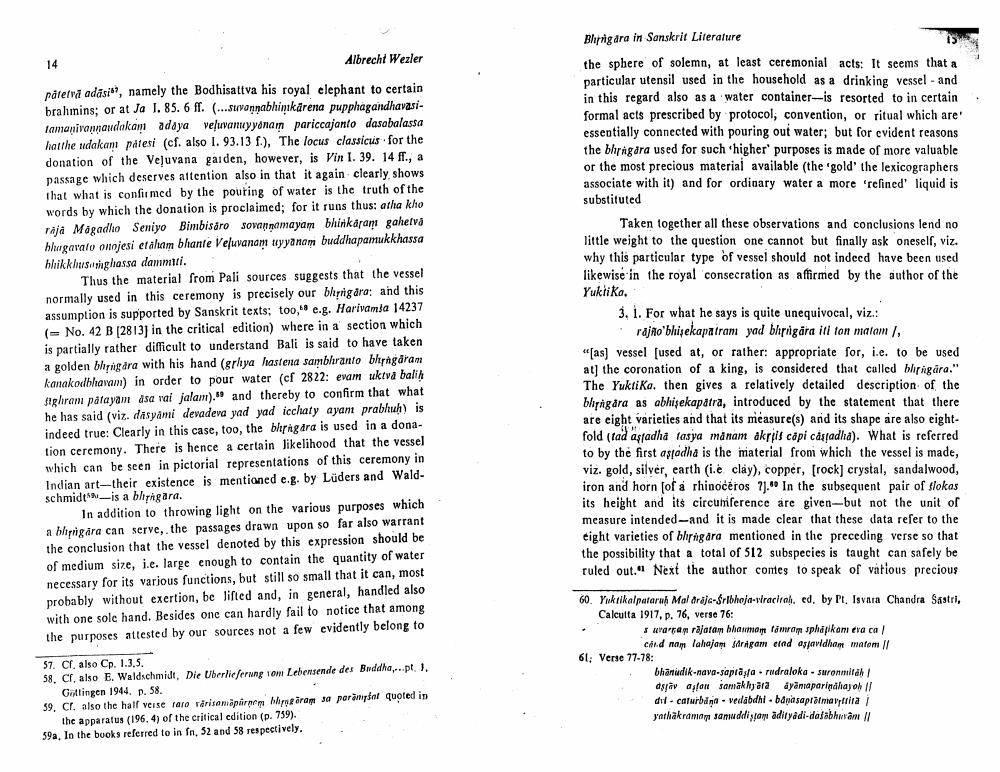Book Title: Bhrngara In Sanskrit Literature Author(s): A Wezler Publisher: A Wezler View full book textPage 8
________________ Bhrrigara in Sanskrit Literature Albrecht Wezler påterva adasi", namely the Bodhisattva his royal elephant to certain brahmins; or at Ja I. 85. 6 ff. (...Suvannabhiņıkarena pupphagandhavasitamanivannaudakam adaya veluvanuyyanam pariccajanto dasobalassa hattheudakam patesi (cf. also I. 93.13 f.), The locus classicus for the donation of the Veļuvana garden, however, is Vin I. 39. 14 fr., a passage which deserves attention also in that it again clearly shows that what is confirmed by the pouring of water is the truth of the words by which the donation is proclaimed; for it runs thus: atha kho raja Mögadho Seniyo Bimbisaro sovannamayam bhinkaram gahetva hlagavalo onojesi etalam bhante Veluvanam teyyanam buddhapamukkhassa hhikkhusetghassa dammiti. Thus the material from Pali sources suggests that the vessel normally used in this ceremony is precisely our bhrrigara; and this assumption is supported by Sanskrit texts; too, e.g. Harivamsa 14237 ( No. 42 B (2813) in the critical edition) where in a section which is partially rather difficult to understand Bali is said to have taken a golden blirágdra with his hand (grhya hastena sambhranto blingdram kanakodbhawan) in order to pour water (cf 2822: evam uktva balth stghrami palayam asa vai jalam)." and thereby to confirm that what he has said (viz. dasyami devadeva yad yad icchaty ayam prabhuh) is indeed true: Clearly in this case, too, the blurigara is used in a donation ceremony. There is hence a certain likelihood that the vessel which can be seen in pictorial representations of this ceremony in Indian art-their existence is mentioned e.g. by Lüders and Waldschmidt-is a bhagara. In addition to throwing light on the various purposes which a blirrigara can serve, the passages drawn upon so far also warrant the conclusion that the vessel denoted by this expression should be of medium size, i.e. large enough to contain the quantity of water necessary for its various functions, but still so small that it can, most probably without exertion, be lifted and, in general, handled also with one sole hand. Besides one can hardly fail to notice that among the purposes attested by our sources not a few evidently belong to 57. Cr, also Cp. 1.3.5. 58. Cr, also E. Waldschmidt. Die Uberlieferung vom Lebensende des Buddha...pt 1. Gottingen 1944. p. 58. 59. Cr. also the half veise rare rarison aparnom himearam sa paranyfol quoted in the apparatus (196,4) of the critical edition (p. 759). 59a, In the books referred to in fn, 32 and 58 respectively. the sphere of solemn, at least ceremonial acts: It seems that a particular utensil used in the household as a drinking vessel - and in this regard also as a water container-is resorted to in certain formal acts prescribed by protocol, convention, or ritual which are essentially connected with pouring out water; but for evident reasons the bhrigara used for such higher purposes is made of more valuable or the most precious material available (the 'gold' the lexicographers associate with it) and for ordinary water a more 'refined' liquid is substituted Taken together all these observations and conclusions lend no little weight to the question one cannot but finally ask oneself, viz. why this particular type of vessel should not indeed have been used likewise in the royal consecration as affirmed by the author of the Yuktika, 3.1. For what he says is quite unequivocal, viz.: rajno bhisekapatram yad bhriigära iti ton matam , "[as) vessel (used at, or rather: appropriate for, i.e. to be used at] the coronation of a king, is considered that called bhrigára." The Yukli ko. then gives a relatively detailed description of the bliragara as abhisekapátra, introduced by the statement that there are cight varieties and that its measure(s) and its shape are also eightfold (tad asjadha tasya manam akriis capi casadha). What is referred to by the first asjadha is the material from which the vessel is made, viz, gold, silver, earth (ie clay), copper, [rock] crystal, sandalwood, iron and horn (of a rhinocéros 7). In the subsequent pair of Slokas its height and its circunference are given-but not the unit of measure intended-and it is made clear that these data refer to the tight varieties of bhrigara mentioned in the preceding verse so that the possibility that a total of 512 subspecies is taught can safely be ruled out." Next the author contes to speak of various precious 60. Yuktikalpataruh Malaraja-ribhoja-viracirah. ed. by P. Isvara Chandra Sastri, Calcutta 1917, p. 76, verse 76: 3 urartam rajatam bharmom tamray sphápikam era ca cand nam lahajapt sragam eled asfavidhan matom II 61: Verse 77-78: bhārudik-nava-saptayfa. rudraloka - saronmilah/ dsão asfon samākhyala ay naparinalaj oh / dil - carurbana - vedabdhi. bapa saprotnia vytrina yathakraman sanuddistamadityadi-dašābhusan IIPage Navigation
1 ... 6 7 8 9 10 11 12 13 14 15 16 17 18 19 20 21 22 23
